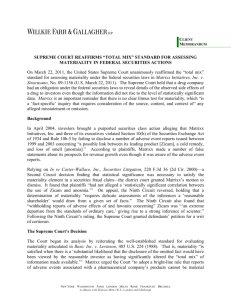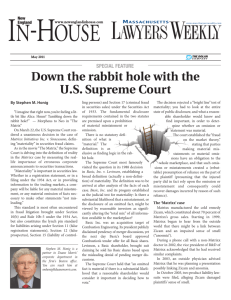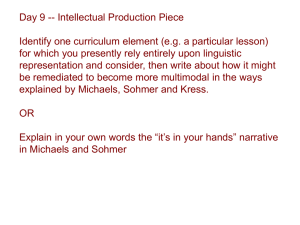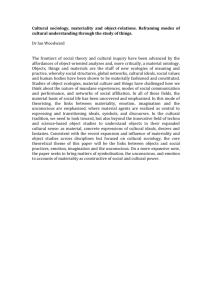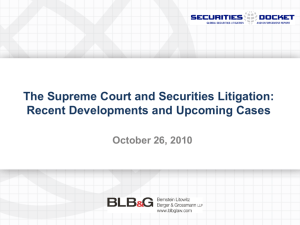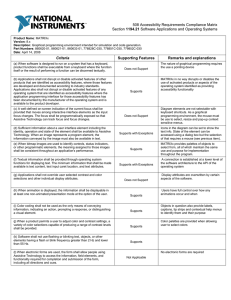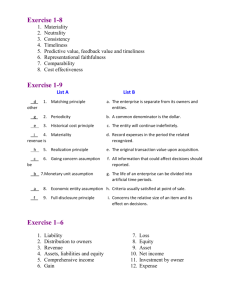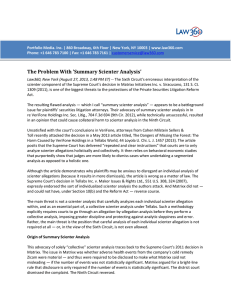Securities Law Update
advertisement
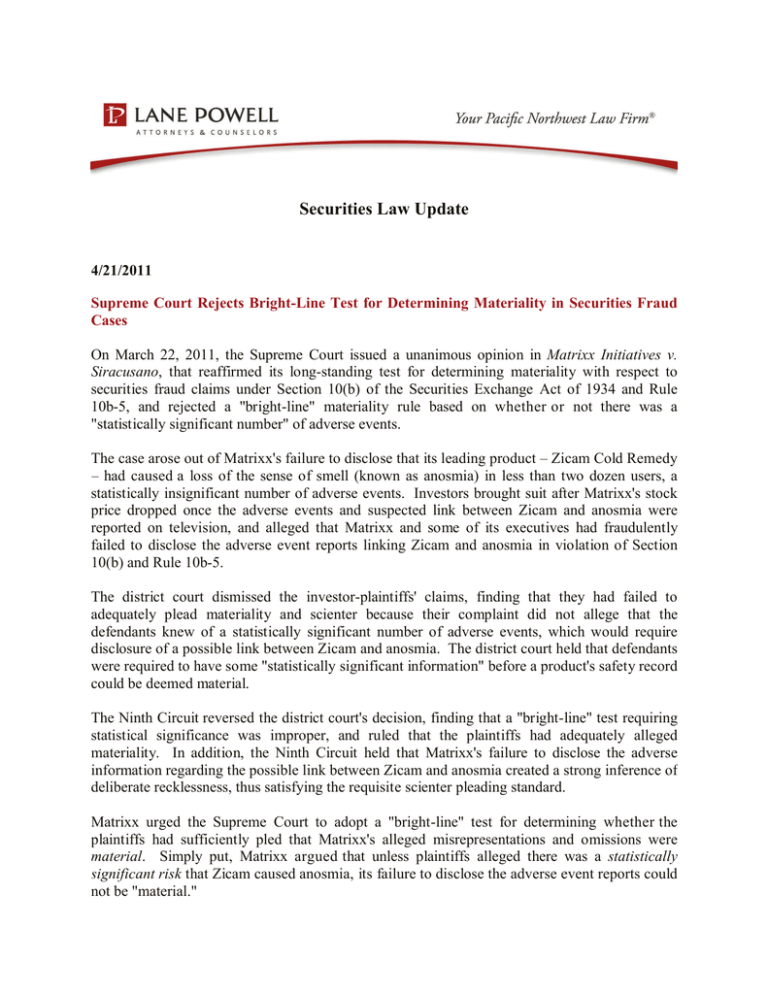
Securities Law Update 4/21/2011 Supreme Court Rejects Bright-Line Test for Determining Materiality in Securities Fraud Cases On March 22, 2011, the Supreme Court issued a unanimous opinion in Matrixx Initiatives v. Siracusano, that reaffirmed its long-standing test for determining materiality with respect to securities fraud claims under Section 10(b) of the Securities Exchange Act of 1934 and Rule 10b-5, and rejected a "bright-line" materiality rule based on whether or not there was a "statistically significant number" of adverse events. The case arose out of Matrixx's failure to disclose that its leading product – Zicam Cold Remedy – had caused a loss of the sense of smell (known as anosmia) in less than two dozen users, a statistically insignificant number of adverse events. Investors brought suit after Matrixx's stock price dropped once the adverse events and suspected link between Zicam and anosmia were reported on television, and alleged that Matrixx and some of its executives had fraudulently failed to disclose the adverse event reports linking Zicam and anosmia in violation of Section 10(b) and Rule 10b-5. The district court dismissed the investor-plaintiffs' claims, finding that they had failed to adequately plead materiality and scienter because their complaint did not allege that the defendants knew of a statistically significant number of adverse events, which would require disclosure of a possible link between Zicam and anosmia. The district court held that defendants were required to have some "statistically significant information" before a product's safety record could be deemed material. The Ninth Circuit reversed the district court's decision, finding that a "bright-line" test requiring statistical significance was improper, and ruled that the plaintiffs had adequately alleged materiality. In addition, the Ninth Circuit held that Matrixx's failure to disclose the adverse information regarding the possible link between Zicam and anosmia created a strong inference of deliberate recklessness, thus satisfying the requisite scienter pleading standard. Matrixx urged the Supreme Court to adopt a "bright-line" test for determining whether the plaintiffs had sufficiently pled that Matrixx's alleged misrepresentations and omissions were material. Simply put, Matrixx argued that unless plaintiffs alleged there was a statistically significant risk that Zicam caused anosmia, its failure to disclose the adverse event reports could not be "material." Resolving a split among the federal circuit courts regarding the materiality of adverse events associated with pharmaceutical products, the Supreme Court affirmed the Ninth Circuit's ruling. The Court declined to adopt the "bright-line" test, rejecting the "statistically significant information" requirement, and reaffirmed the standard for determining materiality in securities fraud cases that it had articulated in Basic, Inc. v. Levinson, 485 U.S. 224 (1988). Under that standard, materiality is established when there is a substantial likelihood that disclosure of the omitted fact would have been viewed by a reasonable investor as having significantly altered the "total mix" of information available. The Court further held that materiality is fact-specific and that the Basic standard could be satisfied even without statistically significant evidence of a causal link between the reported adverse events (anosmia) and Matrixx's product (Zicam). In this regard, the Court noted that because "medical professionals and regulators act on the basis of evidence of causation that is not statistically significant," reasonable investors might also act on statistically insignificant information in making investment decisions. Ultimately, the Court found it plausible that there was a causal link between Zicam and anosmia and that such a link was material. Finally, the Court held that plaintiffs' complaint had adequately pled scienter, rejecting Matrixx's second proposed "bright-line" rule that statistical significance must be present to establish the requisite strong inference of scienter. The Court focused on what could plausibly be inferred from the facts alleged about defendants' understanding of the materiality of the adverse event reports, as opposed to their mere possession of that information. Although the lack of statistically significant information could have suggested simply that defendants did not think such information was material, the Court found instead that the allegation they were "concerned" about a possible link to anosmia—coupled with other factors such as Matrixx's issuance of a misleading press release—rendered the plaintiffs' scienter allegations sufficient to defeat a motion to dismiss. This decision has potential implications for (i) disclosure obligations of public companies, and (ii) public companies' ability to obtain dismissals of some types of securities fraud lawsuits. First, the Court's rejection of a "statistically significant" rule requires that companies, once they become aware of adverse event reports, analyze those reports to determine their materiality. Public disclosure may be necessary in light of the adverse event report's source, content and context. Although the Court emphasized that Section 10(b) and Rule 10b-5 do not create an affirmative duty to disclose all adverse or material information, disclosure is required when it is necessary to ensure that statements the issuer has made or is making are not misleading. Second, the Matrixx Court's rejection of a "bright-line" materiality test arguably eases the plaintiffs' burden in alleging materiality to support a securities fraud claim. In deciding that failure to disclose statistically significant information need not be alleged to adequately plead materiality, the odds that plaintiffs may survive a motion to dismiss are seemingly enhanced. Nevertheless, the Court stood by its decision in Basic v. Levinson, and its ruling in Matrixx does not alter the well-established "total mix of information available" standard for materiality, or the requirement that plaintiffs allege facts raising a "strong inference" of scienter to proceed with a federal securities fraud claim. 2 For more information, please contact the Securities Law Practice Group at Lane Powell: lanepowellpc@lanepowell.com This is intended to be a source of general information, not an opinion or legal advice on any specific situation, and does not create an attorney-client relationship with our readers. If you would like more information regarding whether we may assist you in any particular matter, please contact one of our lawyers, using care not to provide us any confidential information until we have notified you in writing that there are no conflicts of interest and that we have agreed to represent you on the specific matter that is the subject of your inquiry. Copyright © 2011 Lane Powell PC Seattle | Portland | Anchorage | Olympia | Tacoma | London 3
